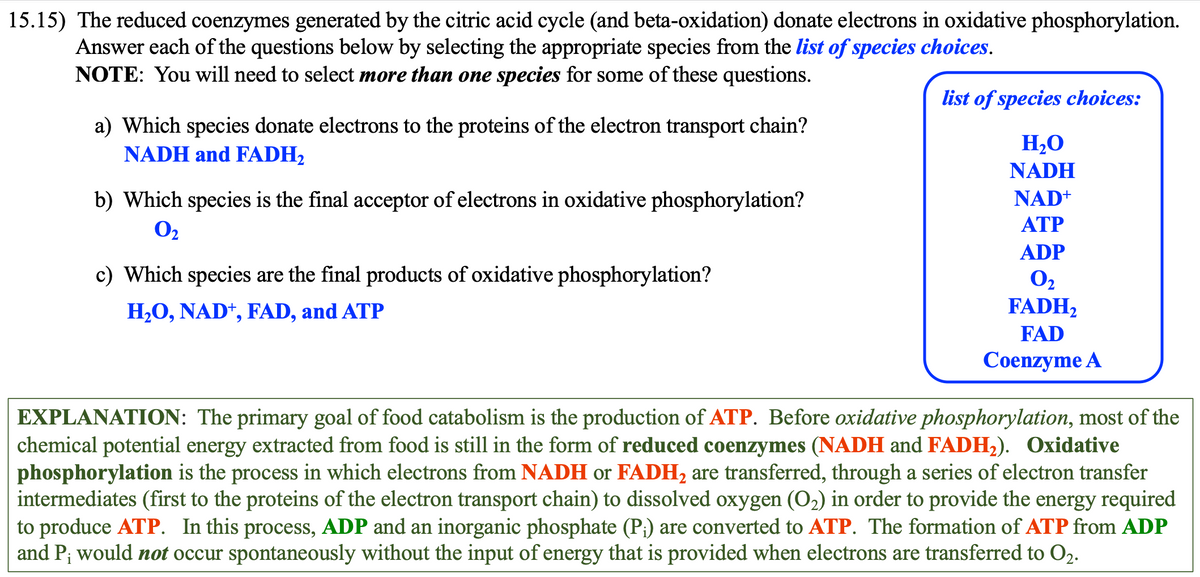15.15) The reduced coenzymes generated by the citric acid cycle (and beta-oxidation) donate electrons in oxidative phosphorylation. Answer each of the questions below by selecting the appropriate species from the list of species choices. NOTE: You will need to select more than one species for some of these questions. a) Which species donate electrons to the proteins of the electron transport chain? NADH and FADH₂ b) Which species is the final acceptor of electrons in oxidative phosphorylation? 0₂2 c) Which species are the final products of oxidative phosphorylation? H₂O, NAD+, FAD, and ATP list of species choices: H₂O NADH NAD+ ATP ADP 0₂ FADH₂ FAD Coenzyme A EXPLANATION: The primary goal of food catabolism is the production of ATP. Before oxidative phosphorylation, most of the chemical potential energy extracted from food is still in the form of reduced coenzymes (NADH and FADH₂). Oxidative phosphorylation is the process in which electrons from NADH or FADH₂ are transferred, through a series of electron transfer intermediates (first to the proteins of the electron transport chain) to dissolved oxygen (O₂) in order to provide the energy required to produce ATP. In this process, ADP and an inorganic phosphate (P;) are converted to ATP. The formation of ATP from ADP and P; would not occur spontaneously without the input of energy that is provided when electrons are transferred to O₂.
Electron Transport Chain
The electron transport chain, also known as the electron transport system, is a group of proteins that transfer electrons through a membrane within mitochondria to create a gradient of protons that drives adenosine triphosphate (ATP)synthesis. The cell uses ATP as an energy source for metabolic processes and cellular functions. ETC involves series of reactions that convert redox energy from NADH (nicotinamide adenine dinucleotide (NAD) + hydrogen (H)) and FADH2(flavin adenine dinucleotide (FAD)) oxidation into proton-motive force(PMF), which is then used to synthesize ATP through conformational changes in the ATP synthase complex, a process known as oxidative phosphorylation.
Metabolism
Picture a campfire. It keeps the body warm on a cold night and provides light. To ensure that the fire keeps burning, fuel needs to be added(pieces of wood in this case). When a small piece is added, the fire burns bright for a bit and then dies down unless more wood is added. But, if too many pieces are placed at a time, the fire escalates and burns for a longer time, without actually burning away all the pieces that have been added. Many of them, especially the larger chunks or damp pieces, remain unburnt.
Cellular Respiration
Cellular respiration is the cellular process involved in the generation of adenosine triphosphate (ATP) molecules from the organic nutritional source obtained from the diet. It is a universal process observed in all types of life forms. The glucose (chemical formula C6H12O6) molecules are the preferred raw material for cell respiration as it possesses a simple structure and is highly efficient in nature.
Can u help me to explain to me part a, part b, part c, please? I stuggled.

Step by step
Solved in 5 steps


